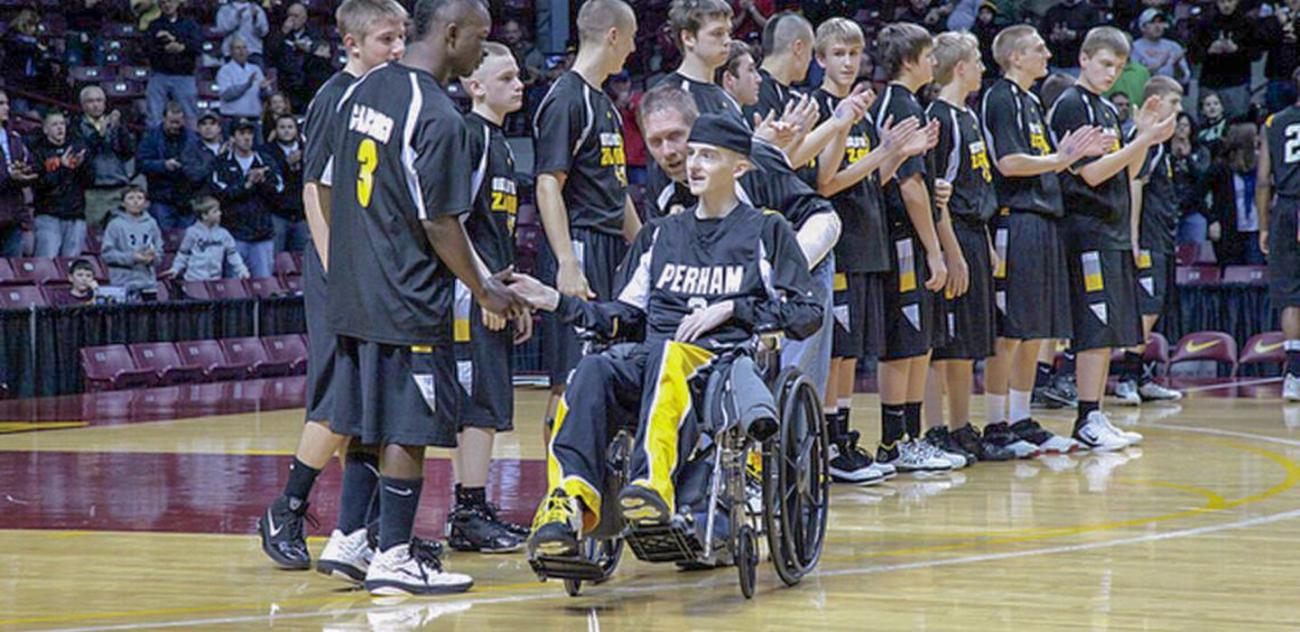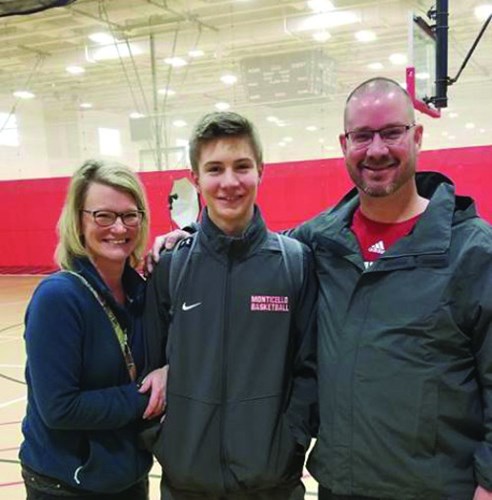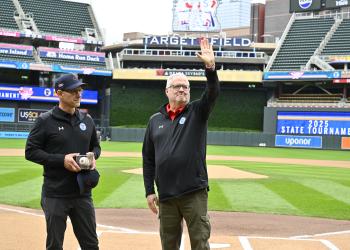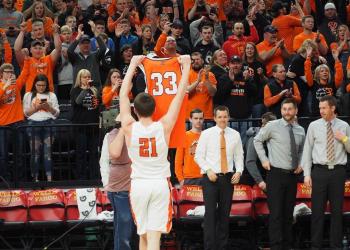John’s Journal: Saving Lives Takes Planning, Practice
MSHSL Schools Have Seen Incidents Similar To Buffalo Bills’ Damar Hamlin
Posted: Friday, January 6, 2023 - 12:33 PM

Zach Gabbard was reunited with the Perham boys basketball team at the 2011 state tournament. (Photo by Robert Williams, Forum News Service.)

Monticello's Ryan Monahan with his parents, Cindy and John.
I was watching the NFL game between Buffalo and Cincinnati earlier this week, anticipating the matchup of playoff-bound teams. And then Buffalo’s Damar Hamlin collapsed on the field.
Seeing medical professionals at work, hearing that Hamlin had received Cardiopulmonary Resuscitation (CPR) and that an Automated External Defibrillator (AED) had been used, several names came to mind.
Zach Gabbard.
Dale Wakasugi.
Laura Griffiths.
Ryan Monahan.
Brad Wendland.
Brayden Weber.
Mike Canfield.
They don’t know each other but they have something in common: They all suffered traumatic cardiac issues and their lives were saved. That’s because their incidents happened during high school activities, people on site were trained in the use of AEDs and CPR, and schools had Emergency Action Plans in place. Those Emergency Action Plans, which the MSHSL encourages all schools to develop and practice, are a vital life-saving practice. The MSHSL also requires all coaches to fulfill Coaches Education Requirements, including AED training.
All NFL teams have similar plans, which are practiced throughout the season. NFL organizations have medical professionals on hand at all practices and games, and when something tragic happens, they spring into action. The best-case scenario for high schools is that the same thing will happen when someone is in trouble.
Of the names listed above, Laura Griffiths is the only one who didn’t collapse at a practice or game. She was a basketball player at Cherry High School who collapsed the morning after Cherry's final regular-season home game in 2007. She was diagnosed with an electrical abnormality that can cause the heart to race. After that, she was forced to carry an AED in case her heart began beating at a dangerous level. Her issue was solved surgically, with the procedure paid for by Mark Dayton, who had left the U.S. Senate and would become the governor of Minnesota. (Read about Laura here: https://www.mshsl.org/about/news/johns-journal/johns-journal-when-us-senator-came-aid-cherry-high-school-athlete )
Dale Wakasugi was a veteran basketball official who collapsed on the court during a 2007 game at Fridley High School. Dale suffered a Myocardial Infarction caused by a blockage of his Left Anterior Descending artery. The hero was 11th-grader Lindsey Paradise, who had learned how to perform CPR and use an AED just three weeks earlier during health class.
During a March 2011 basketball game at Dilworth-Glyndon-Felton, Perham’s Zach Gabbard collapsed. He suffered cardiac arrest, life-saving measures were performed and he was rushed to a hospital in Fargo. After several touch-and-go days he was transferred to a hospital at the University of Minnesota in Minneapolis, and later to a rehabilitation hospital in St. Paul.
In one of the most moving moments I have witnessed, Zach surprised his teammates by coming to Williams Arena (in a wheelchair) to be on hand when they played in the state tournament. A movie was made about Zach’s experience. (Read about Zach here: https://old.mshsl.org/mshsl/johnsjournal.asp?index=2304 )
As practice was beginning for the 2017 basketball season, a Monticello sophomore named Ryan Monahan collapsed during an early-morning workout at school. It was his heart. Thankfully, all the Monticello coaches who were in the building that day had completed their required AED training and the school had an Emergency Action Plan in place.
“When you put this plan together, you know you can’t do everything yourself,” said Jason Schmidt, who was the head boys basketball coach. “Fortunately, we had all those people there. No one in the gym had used an AED in the past. We had done our training, and probably like everyone else you assume you’re never going to have to use it. And then you do.” (Click here and scroll to the fourth headline to read about Ryan: https://old.mshsl.org/mshsl/johnsjournal.asp?index=627 )
When veteran football official Mike Canfield went down with a cardiac issue during a junior varsity game at Kimball High School in 2019, a plan to save his life was already in place. And because the plan was executed to perfection, Mike’s life was indeed saved.
Coaches and others followed Kimball’s Emergency Action Plan and were ready when the emergency happened.
"We did have a plan," said Kimball activities director Byron Westrich, “and one of my coaches texted me right away, saying ‘Thank goodness you had that plan.’ It worked like clockwork.”
Kimball assistant football coach Jamie Leither said, “Everybody did their job without hesitation and together saved a life. The plan that was put together for us worked to a T. I hope we never have to use the plan again, but we know that it does work.” (Read about Mike here: https://www.mshsl.org/about/news/johns-journal/best-2019-20-number-5-because-plan-was-place-officials-life-was-saved )
Becker High School wrestler Brayden Weber was competing in the 2020 state tournament semifinals at Xcel Energy Center when he collapsed with a heart issue. After shaking hands with his opponent as the match ended, he went down much like Damar Hamlin.
CPR was performed by Dr. Mark Berg of M Health Fairview, assisted by athletic trainers Jenna Arnold and Karin Shelstad from the Institute for Athletic Medicine. Doctors and athletic trainers are on hand at all MSHSL state tournaments, for which Brayden is very thankful.
“What if I'm home alone or whatever, somewhere by myself? That goes through your mind,” he said.
Brayden, who was diagnosed with ventricular tachycardia -- a heart rhythm disorder caused by abnormal electrical signals – is now playing football at North Dakota State. (Read about Brayden here: https://www.mshsl.org/about/news/johns-journal/best-2019-20-number-3-brayden-weber-good-indication-i-was-dead )
Late in the opening game of the 2021 football season, Waseca head coach Brad Wendland collapsed on the sideline due to sudden cardiac arrest. Athletic trainers from Waseca and St. Peter (the visiting team), joined by a nurse who was in the stands and others, saved his life. They maintained his airway, they did chest compressions, they used an AED to shock his heart.
Troy Hoehn, the athletic trainer at Waseca High School, ran to Wendland and started yelling his name. There was no response. St. Peter athletic trainer Leah Rutz sprinted across the field. Krystal Malis, who works as an emergency room nurse at Mayo Clinic Health System Hospital in Waseca and has two sons who play football, ran down from the stands and leaped over the fence that surrounds the field. Waseca activities director Joe Hedervare, who was in the press box, rushed to the field while dialing 911.
When I talked to Brad two weeks later in writing about what happened, he said, “You’d better put in (the story) the importance of CPR training and having AEDs available. If one person hears it and does it, or one person in the crowd that night gets a checkup or asks at work, ‘Where’s our AED,’ or gets trained in CPR, it will be worth it.”
Five years earlier, Waseca didn’t have athletic trainers at most events.
“Mayo started ramping up athletic training services in our area, and that shouldn’t be overlooked,” Hedervare said. “Five years ago this story could have been completely different. I communicate what comes from the League. We have to have emergency plans in place, we have to practice them, everybody has to be aware of what’s going on, especially at a practice situation. If it would have happened anywhere else, I’m not sure our response would have been good.
“We have Emergency Action Plans for all our teams. I have heard from people (at other schools), saying they’re going to take these things a lot more seriously. This drove the point home, that we were able to implement this at a home event and it went as well as it did. It’s humbling, it’s crazy. We’re so glad we have the plan in place and everything worked out as it did.” (Read about Brad Wendland here: https://www.mshsl.org/about/news/johns-journal/johns-journal-every-day-good-day-wasecas-wendland )
Trained medical personnel. AEDs on site. Plans in place for when an emergency happens. That’s how lives are saved.
--MSHSL media specialist John Millea has been the leading voice of Minnesota high school activities for decades. Follow him on Twitter @MSHSLjohn and listen to "Preps Today with John Millea” wherever you get podcasts. Contact John at [email protected]





